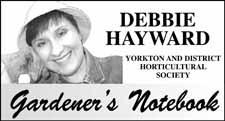I guess there's one thing we can say about ourselves, gardeners: we are resilient! The heat of recent days, and the storm last week, has been hard on our plants and on us! But it's amazing how the heat has made everything go into "fast forward". A gardening friend was saying how her lilies are in full bloom, and these particular varieties don't usually come into their own until later in July. Have you noticed that in your own garden?
The other day we were visiting with some dear friends who are both also avid gardeners, and one of them had an article about wildflower gardening from an English paper. The accompanying picture was stunning, of a wide, beautiful field filled with the most amazing and colorful plants. By coincidence, at the same time, I was reading about wildflower gardening in a book called "Yardening: the Nongardener's Guide To Creating A Beautiful Landscape" by Jeff and Liz Ball. I'll tell you what they had to say about the subject.
According to Jeff and Liz, wildflower gardens are great "space fillers", especially for gardeners who are looking for lawn alternatives. But, (and this is very true), wildflower seed mixtures that your purchase commercially are not usually appropriate for all regions. Some seeds may not germinate at all, and if they do, they may not be suited to our climate. The mixtures may also contain a mix of annuals and perennials, and plants of varying heights, which is of course how wildflowers would grow is they were "wild", but when we are trying to cultivate that, they could end up looking patchy and messy.
It is very important to obtain wildflowers that are suited to our prairie climate. If you check at your local greenhouses or go on-line and type in "prairie wildflower seeds" or "Saskatchewan wildflower seeds", you will find a starting point of what plants would be good choices.
The other thing about wildflower gardens is that they are not "maintenance free". The Ball's compared it to starting a lawn in terms of preparation and effort. Begin in the fall. First, the area would have to be sprayed with an effective herbicide; then two weeks later, mow down the dead plants as close as possible to the soil. You may have to treat with a second round of herbicide if new weeds have sprouted. Then, rake the area so that you pick up any debris, and to loosen the soil to accept the new wildflower seeds. Then sow the seeds. Come spring, you may have to water the area till the seedlings are on their way. And of course, you will have to weed and pull out the obvious suspects like thistles, dandelions, etc. Then in the fall, after everything has finished blooming, you can mow it.
Wildflower gardens are hardly the easy way out to escape a lawn or garden! But I'm sure that for those who are willing to put in the work needed, the results could be very rewarding.
Remember, the Yorkton in Bloom competition is coming! Entries will be accepted until July 20 at 4 p.m. The judging will be from July 23 to 25. There is a category for just about everyone: front and back yards, mobile home grounds, vegetable garden, senior housing unit, senior housing complex, senior housing deck or balcony, commercial planter, best residential street, and Golden Bloom categories for gardeners 75 years of age and older. So consider taking part, gardeners! Yorkton residents should be so proud of how beautiful our city looks, and it is because of the pride you all take in your own yards! So don't be shy; enter the contest this year! To register, you can call Darren Spelay at 786-1776.
Have a great week, and remember to wear a hat!




